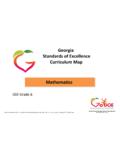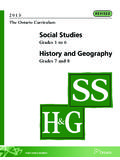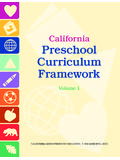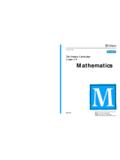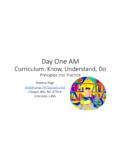Transcription of Fifth Grade Curriculum Map - Georgia Standards
1 Georgia Department of Education Richard Woods, State School Superintendent July 2016 All Rights Reserved GSE Fifth Grade Curriculum Map Unit 1 Unit 2 Unit 3 Unit 4 Unit 5 Unit 6 Unit 7 Unit 8 Order of Operations and Whole Numbers Adding and Subtracting with Decimals Multiplying and Dividing with Decimals Adding, Subtracting, Multiplying and Dividing Fractions 2D Figures Volume and Measurement Geometry and the Coordinate Plane Show What We Know ALL These units were written to build upon concepts from prior units, so later units contain tasks that depend upon the concepts addressed in earlier units. All units will include the Mathematical Practices and indicate skills to maintain.
2 However, the progression of the units is at the discretion of districts. NOTE: Mathematical Standards are interwoven and should be addressed throughout the year in as many different units and tasks as possible in order to stress the natural connections that exist among mathematical topics. Grades 3-5 Key: G= Geometry, MD=Measurement and Data, NBT= Number and Operations in Base Ten, NF = Number and Operations, OA = Operations and Algebraic Thinking. Georgia Department of Education Richard Woods, State School Superintendent July 2016 All Rights Reserved GSE Fifth Grade GSE Fifth Grade Expanded Curriculum Map Standards for Mathematical Practice 1 Make sense of problems and persevere in solving them. 2 Reason abstractly and quantitatively.
3 3 Construct viable arguments and critique the reasoning of others. 4 Model with mathematics. 5 Use appropriate tools strategically. 6 Attend to precision. 7 Look for and make use of structure. 8 Look for and express regularity in repeated reasoning. Unit 1 Unit 2 Unit 3 Unit 4 Order of Operations and Whole Numbers Adding and Subtracting with Decimals Multiplying and Dividing with Decimals Adding, Subtracting, Multiplying, and Dividing Fractions Write and interpret numerical expressions. Use parentheses, brackets, or braces in numerical expressions, and evaluate expressions with these symbols. Write simple expressions that record calculations with numbers, and interpret numerical expressions without evaluating them. For example, express the calculation add 8 and 7, then multiply by 2 as 2 (8 + 7).
4 Recognize that 3 (18932 + 921) is three times as large as 18932 + 921, without having to calculate the indicated sum or product. Understand the place value system. Recognize that in a multi-digit number, a digit in one place represents 10 times as much as it represents in the place to its right and 1/10 of what it represents in the place to its left. Explain patterns in the number of zeros of the product when multiplying a number by powers of 10, and explain patterns in the placement of the decimal point when a decimal is multiplied or divided by a power of 10. Use whole-number exponents to denote powers of 10. Understand the place value system. Recognize that in a multi-digit number, a digit in one place represents 10 times as much as it represents in the place to its right and 1/10 of what it represents in the place to its left.
5 Read, write, and compare decimals to thousandths. a. Read and write decimals to thousandths using base-ten numerals, number names, and expanded form, , = 3 100 + 4 10 + 7 1 + 3 (1/10) + 9 (1/100) + 2 (1/1000). b. Compare two decimals to thousandths based on meanings of the digits in each place, using >, =, and < symbols to record the results of comparisons. Use place value understanding to round decimals up to the hundredths place. Perform operations with multi-digit whole numbers and with decimals to hundredths. Add, subtract, multiply, and divide decimals to hundredths, using concrete models or drawings and strategies based on place value, properties of operations, and/or Understand the place value system. Explain patterns in the number of zeros of the product when multiplying a number by powers of 10, and explain patterns in the placement of the decimal point when a decimal is multiplied or divided by a power of 10.
6 Use whole-number exponents to denote powers of 10. Perform operations with multi-digit whole numbers and with decimals to hundredths. Add, subtract, multiply, and divide decimals to hundredths, using concrete models or drawings and strategies based on place value, properties of operations, and/or the relationship between addition and subtraction; relate the strategy to a written method and explain the reasoning used. Use equivalent fractions as a strategy to add and subtract fractions. Add and subtract fractions and mixed numbers with unlike denominators by finding a common denominator and equivalent fractions to produce like denominators. Solve word problems involving addition and subtraction of fractions, including cases of unlike denominators ( , by using visual fraction models or equations to represent the problem).
7 Use benchmark fractions and number sense of fractions to estimate mentally and assess the reasonableness of answers. For example, recognize an incorrect result 2/5 + = 3/7, by observing that 3/7 < . Apply and extend previous understandings of multiplication and division to multiply and divide fractions. Interpret a fraction as division of the numerator by the denominator (a/b = a b). Solve word problems involving division of whole numbers leading to answers in the form of fractions or mixed numbers, , by using visual fraction models or equations to represent the problem. Example: 35 can be interpreted as 3 divided by 5 and as 3 shared by 5 . Apply and extend previous understandings of multiplication to multiply a fraction or whole number by a fraction.
8 Georgia Department of Education Richard Woods, State School Superintendent July 2016 All Rights Reserved Perform operations with multi-digit whole numbers and with decimals to hundredths. Fluently multiply multi-digit whole numbers using the standard algorithm (or other strategies demonstrating understanding of multiplication) up to a 3 digit by 2 digit factor. Fluently divide up to 4-digit dividends and 2-digit divisors by using at least one of the following methods: strategies based on place value, the properties of operations, and/or the relationship between multiplication and division. Illustrate and explain the calculation by using equations or concrete models. ( , rectangular arrays, area models) the relationship between addition and subtraction; relate the strategy to a written method and explain the reasoning used.
9 A. Apply and use understanding of multiplication to multiply a fraction or whole number by a fraction. Examples as 1 and = b. Find the area of a rectangle with fractional side lengths by tiling it with unit squares of the appropriate unit fraction side lengths, and show that the area is the same as would be found by multiplying the side lengths. Interpret multiplication as scaling (resizing), by: a. Comparing the size of a product to the size of one factor on the basis of the size of the other factor, without performing the indicated multiplication. Example 4 x 10 is twice as large as 2 x 10. b. Explaining why multiplying a given number by a fraction greater than 1 results in a product greater than the given number (recognizing multiplication by whole numbers greater than 1 as a familiar case); explaining why multiplying a given number by a fraction less than 1 results in a product smaller than the given number; and relating the principle of fraction equivalence a/b = (n a)/(n b) to the effect of multiplying a/b by 1.
10 Solve real world problems involving multiplication of fractions and mixed numbers, , by using visual fraction models or equations to represent the problem. Apply and extend previous understandings of division to divide unit fractions by whole numbers and whole numbers by unit fractions. 1 a. Interpret division of a unit fraction by a non-zero whole number, and compute 1 Students able to multiply fractions in general can develop strategies to divide fractions in general, by reasoning about the relationship between multiplication and division. But division of a fraction by a fraction is not a requirement at this Grade . Georgia Department of Education Richard Woods, State School Superintendent July 2016 All Rights Reserved such quotients.











